Open-Source AI vs. Closed Models: How DecentralGPT Makes Advanced AI Accessible and Affordable

A visual contrast between open-source freedom and closed AI restrictions, featuring a transparent brain vs. a locked black box
Introduction
Recently, OpenAI and other major labs have started releasing open-weight models such as gpt-oss-120B and LLaMA, signaling a shift in AI access. Open-source models democratize AI by giving individuals, researchers, and startups full transparency and control. In a landscape where closed-source models dominate premium access, DecentralGPT stands out by embracing open-source AI and delivering affordable, borderless inference using its decentralized GPU network.
Why Open‑Source Models Matter Today
• Transparency & Trust: Open-weight models allow users to inspect, fine-tune, and audit the code—enhancing trust in how AI makes decisions and handles data.cisa.gov+5DecentralGPT+5Tiger Brokers+5Business InsiderWIRED+1
• Low-cost Access: Many open models—like DeepSeek R1, GPT‑oss, and Qwen3—can run on consumer hardware or decentralized infrastructure without expensive licenses.DecentralGPT
• Innovation & Equity: Open models encourage global collaboration and prevent monopolization of AI capabilities, offering diverse voices and use cases the chance to build.WIRED+15apnews.com+15en.wikipedia.org+15
In contrast, closed-source models often restrict access, hide their inner workings, and introduce vendor lock-in.
How DecentralGPT Leverages Open-Source Strengths
1. Integrated Open-Weight Models
DecentralGPT already offers open models like DeepSeek R1, LLaMA 4.0, and soon gpt-oss-120B—all accessible in one unified UI.
2. Web2 & Web3 Access
Users from all backgrounds can use AI—no need to register, pay fiat, or own crypto wallet. Devs or Web3 users can instead pay via $DGC token, unlocking agent tools and context NFTs.
3. Decentralized Compute via DePIN
Thanks to our distributed GPU network, AI inference runs at up to 80% lower cost than centralized cloud providers—without sacrificing speed or reliability.
4. Open-Source Transparency
Every model running on our system is verifiable and modifiable. Developers can audit performance, track updates, or fine-tune for specialized tasks.
5. Fair Token Economy
Users pay using $DGC, which is then burned—creating real demand and deflationary incentives. Node operators earn $DGC for contributing GPU power. Open-source + open access = sustainable AI economy.
Final Thoughts
As major platforms pivot between open and closed models, the importance of accessible AI grows. DecentralGPT empowers users with open-source access, transparent infrastructure, and token-based incentives. That means real AI for real people, not locked behind central gatekeepers.
Ready to try open-source LLMs in a decentralized setup?
Visit DecentralGPT.org & hit Get Started: www.decentralgpt.org
Want to earn rewards or run a node?
Learn more at DeGPT.ai: https://www.degpt.ai
Join our Web3 & AI community
Telegram: t.me/DecentralGPT: https://t.me/decentralgpt